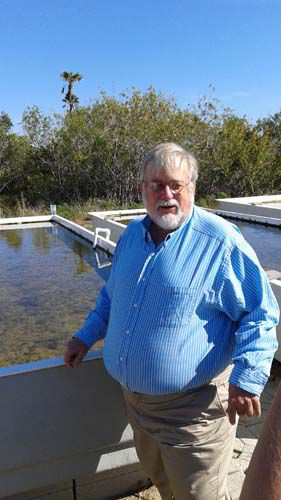
Dennis Hanisak, Ph.D., a research scientist who has worked at Harbor Branch Oceanographic Institute since the 1970s, has created an innovative seagrass nursery that holds promise for repairing damage done to the Indian River Lagoon by a series of disastrous algae blooms and the ongoing pollution of the waterway.
He is growing his first crop this spring in an array of large tanks and hopes to begin replanting the lagoon this summer to determine if nursery-grown seagrass will thrive and spread.
The catastrophic 2011 “superbloom” and others that followed consumed oxygen and clouded the water in the lagoon, cutting off light to aquatic plants and killing much of the seagrass between Vero and the northern end of the waterway.
“In the St. Johns Water Management District, seagrass covered approximately 70,000 acres in 2009,” says Chuck Jacoby, an environmental scientist with St. Johns. “In 2011, seagrass cover was reduced to about 38,000 acres. Seagrass expanded to 48,000 acres in 2015, [but] . . . we anticipate that the 2017 maps will show a loss of seagrass from 2015 because seagrass is either gone or does not extend far offshore.”
That is very bad news because seagrass is the lifeblood of the lagoon, serving as a nursery for juvenile fish, habitat for shrimp and other marine creatures and a food staple for manatees. If the loss persists, it “could be a staggering blow to the regional economy that is dependent upon the estuary, particularly its fisheries,” according to a report released by St. Johns River Water Management District.
Enter Hanisak and his team at Florida Atlantic University’s Harbor Branch in Fort Piece with an experimental seagrass nursery that could have significant implications for restoration of the waterway.
“The health of the seagrass is directly tied to the overall health of the lagoon,” says Hanisak, director of the Marine Ecosystem Health program at Harbor Branch.
With that knowledge in mind, Harbor Branch and St. Johns tried transplanting seagrass from one location in the lagoon to another in 2013. “We harvested small seagrass plugs from places where grass was still healthy and planted them in one-meter plots where no grass remained,” Hanisak says.
There was some success, but scientists realized this was not a sustainable solution, and the idea of a seagrass nursery was born.
Now, Hanisak, technician Richard Mulroy and others at Harbor Branch’s aquaculture facility are growing their first crop in six large tanks. The 20-foot by 6-foot fiberglass tanks, fabricated in Miami and shipped to Fort Pierce, sit outdoors, open to the air and sun, a short distance from the shore of the lagoon.
They contain hopeful shoots of shoal grass (Halodule beaudettei), the most tolerant of the seven species of seagrass that inhabit the lagoon. “It’s not temperature-sensitive,” Hanisak says. “It can grow in water from 35 degrees all the way to 94 degrees.”
Spring is the season when seagrass grows and spreads in the lagoon and the same thing seems to be happening beneath the surface of the clear, brackish water in the tanks where Hanisak’s grass is getting thicker, rooted in a sand and soil mixture that mimics the lagoon bottom.
Hanisak hopes the next phase of the experiment – transplantation of the seagrass from the nursery tanks to multiple locations in the lagoon – can occur this summer. The goal is to plant up to an acre of seagrass in two locations – larger expanses than the small plots tried in the 2013.
“We will need to be able to grow seagrasses outside the lagoon if we want to attempt large-scale rehabilitation,” says Jacobi.
“Realistically, it’s not going to happen overnight,” Hanisak says. “It’s going to take a lot of seagrass.”



